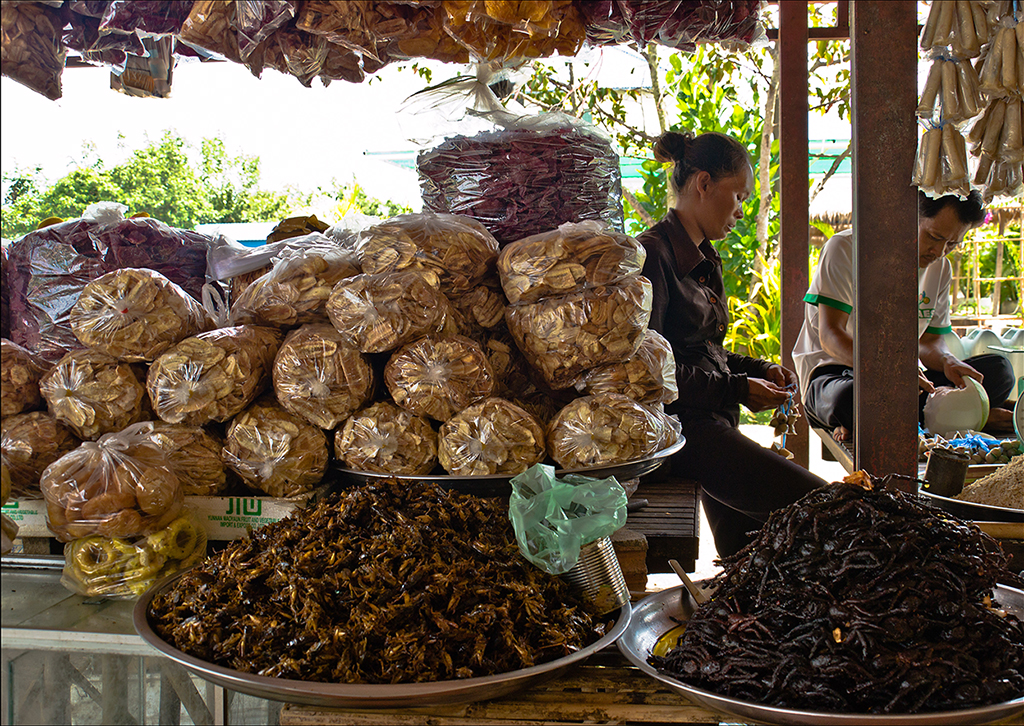Insect consumption provides up to twelve times more iron than beef
The production process for these living organisms is far more sustainable and efficient than cattle production
Smoked onion and barbecue sauce flavoured worm snacks and energy bars containing cricket flour are two of the insect-based food products now being sold in stores in Spain. These products are manufactured entirely in Europe and, according to the experts, fully comply with all the relevant quality standards. Even though human consumption of insects has, until now, always been associated with Asian, African and Latin American countries, as of the beginning of this year, these products have also now been approved for sale in the European Union.
According to the Food and Agriculture Organization of the United Nations (FAO), more than 2,000 million people around the world consume this type of food and, in fact, some experts are now calling them the food of the future as a result of their nutritional properties and benefits. UOC Master's Degree in Nutrition and Health course instructor Sílvia De Lamo points out that the high fat, protein, vitamin and mineral content of insects makes them a highly nutritious and healthy food source. In fact, the consumption of mopane caterpillars provides up to twelve times more iron than the consumption of beef.
Nutritional value varies considerably from one species to another, and even within the same species, depending on the metamorphic phase, diet and habitat of the insect in question. The professor goes on to say that, "In general, tarantulas are very rich in proteins, crickets in calcium and termites in omega 9".
However, many of these living organisms also contain high levels of chitin, a substance that is currently being studied for its potential risk to health and the allergies that may be developed as a result of its consumption. "We need to understand the role played by the enzymes present in the gastrointestinal tract of insects, as well as levels of contamination in terms of microbes and chemical waste", she adds. We also need to learn about consumption practices, as, for example, the ingestion of lobster legs can lead to constipation.
Despite this, UOC Faculty of Health Sciences course instructor Àlex Vidal has no concerns about the quality of these food products once they go on sale, stressing that, "These products need to pass the same quality health checks as other products, in fact, as new products they will be subject to even more stringent controls".
Initiatives to overcome preconceptions
What is not so clear is whether there is a place for the consumption of insects within Mediterranean culture. De Lamo says that, for European consumers, the idea of eating whole insects is met with "outright rejection and a sense of disgust". Vidal says that although it may initially present "a pretty significant challenge for people, they are certain to quietly become part of our eating habits until they secure a place as part of our diet", as, for example, cherry tomatoes and avocados have.
"The easiest way to introduce these foods to the public is by presenting them as ingredients added to energy bars, hamburgers, cakes or bread", says the professor. However, there are now a very significant number of experts who advocate that if consumers are informed of the benefits to be obtained from the whole consumption of these organisms, it "will become more accepted by society".
In fact, in places like the Netherlands and the United States, initiatives to promote the consumption of this type of food are already being carried out, such as "bug banquets", in which chefs present a selection of dishes made using insects and explain to consumers what they are eating and the specific nutritional benefits of each dish.
An economical and sustainable source of food
The professors say that insect production represents much less impact in terms of the environment in comparison to livestock production, with significantly reduced levels of greenhouse gas emissions. They point out that, "While the production of 1 kg of mealworm protein flour has a carbon footprint of around 25 kg of CO2, the figure for the production of the same amount of beef protein is between 75 and 175 kg of CO2". This food supply delivers further added value in the area of efficiency, since insects require "very small amounts of food" to convert food into protein compared to other animal species.
De Lamo predicts that the Earth will be inhabited by some 9.8 billion people by the year 2050 and that the livestock agricultural system will not be able to provide sufficient animal-derived protein to feed the entire planet. Vidal says that the incorporation of insects into our diets "could be a very good option for combating malnutrition" in those areas that do not have the capacity, resources or purchasing power to produce food.
"The search for alternative sources of animal protein has been going on for a long time and insects demonstrate excellent potential with regard to the three factors that are fundamental for society: health, the environment and the economy", the experts conclude.
Experts UOC
Press contact
-
Editorial department
